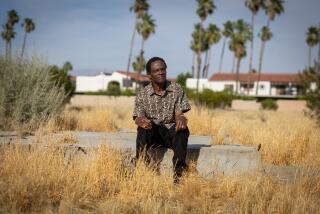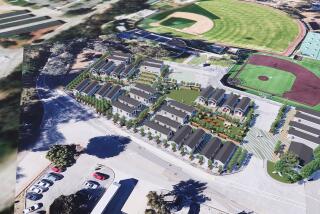Putting to rest tribal remains
It was a five-year tug-of-war that sparked a legal, political and cultural showdown between some of the oldest and newest residents of the Los Angeles region.
On one side: descendants of the Gabrielino-Tongva tribe, natives of the Ballona Wetlands thousands of years ago, outraged that a burial site of almost 400 human remains was being exhumed to clear the path for a waterway in a multibillion-dollar project.
On the other: Playa Vista developers trying to complete that two-phase project -- about 6,000 luxury housing units and more than 3.2 million square feet of office space -- on the cityâs largest remaining undeveloped property.
The burial site was discovered in 2003, prompting strongly-worded letters and lawsuits, but archaeologists hired by Playa Vista kept digging, storing the remains and other artifacts in containers left in a nearby trailer as the courts weighed in.
âItâs been a very disheartening and difficult process,â said Robert Dorame, a Bellflower resident and tribal chairman of the Gabrielino-Tongva Indians of California. âThey say history repeats itself, and once again we were displaced.â
This summer, however, all 396 human remains and hundreds of artifacts found on Playa Vista grounds will return to the earth, thanks to an agreement reached at a meeting in January where tribal representatives, developers and various local and state officials met for the first time.
âThey should have never removed them,â Dorame said. âBut now that they have, my goal is to get them back in the ground as close [as possible] to where they were taken from.â
The Gabrielino-Tongva tribe inhabited Playa Vista as far back as 6,500 years ago and stayed through the late 1800s, said Donn Grenda, president of Statistical Research Inc., the archaeological company hired to remove and catalog the remains.
Today, the Ballona Wetlands area that the Gabrielino-Tongva once called their spiritual resting place is dotted with bulldozers, traffic, sprawling apartment buildings, and a sports park.
Just a few feet from the park is the waterway, referred to as a riparian corridor by the developers but resembling a drainage ditch. Its construction, to help drain water from the development, led to the unearthing of the burial grounds -- considered by archaeologists to be one of the largest Native American burial sites in the western United States.
Peter Nabokov, a UCLA professor who has taught Native American studies for almost 40 years, said that, in most cases, the exhuming of an entire historical burial site would cause a public outcry.
âWhat people fail to understand is that this is not just history, but there are people still alive whose ancestors are those remains,â Nabokov said.
The discovery of Native American remains is nothing new in Southern California, but Playa Vistaâs situation was distinguished by controversy over how the remains were handled, Nabokov said.
Playa Vista officials said the excavations were permitted under an agreement approved by the U.S. Army Corps of Engineers that was crafted in 1991 and signed by developers and three representatives of the Gabrielino-Tongva tribe. Federal laws designed to protect Native American remains from being removed didnât apply in Playa Vistaâs case because the Gabrielino-Tongva tribe has never been federally recognized.
The agreement was extended in 2001 for 10 years, but Dorame and other tribal leaders contend that they were never notified of the extension. Letters were sent to five tribal leaders, but only one, Martin Alcala, responded in favor of extending the agreement, said Playa Vista spokesman Steve Sugerman.
Dorame viewed his ancestorsâ remains for the first time last month, allowing him to perform a purification ceremony with sage.
Accompanied by Los Angeles City Councilman Bill Rosendahl, Sugerman and an archaeologist, Dorame toured the Playa Vista property, checking out four potential reburial sites, some of which were just a few hundred yards from where the burial site was located.
Sugerman said Playa Vista has promised to not build on the area where the remains will be reinterred, and will construct a memorial called the Discovery Center, a âmuseum without walls,â with exhibits on the history of the Ballona Wetlands and the Gabrielino-Tongva tribe.
Reburial could happen as soon as late June, depending on how soon Dorame determines a site, officials said.
âIâm cautiously optimistic until all those remains are back in the ground,â Rosendahl said. âBut I think weâre finally all in agreement on this one.â
--
More to Read
Sign up for Essential California
The most important California stories and recommendations in your inbox every morning.
You may occasionally receive promotional content from the Los Angeles Times.










